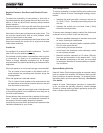
Page 42
7051-158B
December 6, 2011
R
EDGE 60 Pellet Fireplace
G. Pipe Selection Chart
Do NOT pack insulation or other combustibles between
fi restops.
• ALWAYS maintain specifi ed clearances around venting
and fi restop systems.
• Install fi restops as specifi ed.
Failure to keep insulation or other material away from vent
pipe may cause fi re.
Figure 41.1
3 in. or 4 in. (76mm or 102mm) Diameter Pipe
Equivalent Pipe
Length In Feet
ALTITUDE IN THOUSANDS OF FEET
0
20
30
1 2 3 4 5 6 7 8 9 10
4 in. (102mm) Diameter Pipe Only
10
Example 1
Example 2
Example 1: If the equivalent length of pipe is 23 feet (7m) with altitude
of 8,000 feet (2438m) you must use 4 inch (102mm) diameter type “L”
or “PL” vent.
Example 2: If the equivalent length of pipe is 12 feet (3.7m) with altitude
of 6,000 feet (1829m) you may use 3 or 4 inch (76 to 102mm) diameter
type “L” or “PL” vent.
The chart will help you in determining proper venting size
according to the equivalent feet of pipe calculated previously
and the altitude above sea level of this installation.
Figure 41.1.
a. Locate the calculated equivalent feet of pipe on the verti-
cal left side of the chart.
b. Move to the right horizontally on the chart until you reach
your altitude above sea level.
c. If you fall below the diagonal line, 3 or 4 inch (76 to
102mm) pipe may be used.
d. If it is anywhere above the diagonal line, a 4 inch (102mm)
diameter pipe is required.
NOTICE:
• A 90° elbow is 5 times as restrictive to the fl ow of exhaust
gases under positive pressure as 1 foot (305mm) of hori-
zontal pipe.
• A foot of horizontal pipe is twice as restrictive as a foot of
vertical pipe.
WARNING! RISK OF FIRE!
WARNING
It is critical to have a working smoke detector
installed in the home of unit operation.
• Smoke alarms that are properly installed and
maintained play a vital role in reducing fi re deaths and
injuries. Having a working smoke alarm reduces the
chance of fi re related injuries..
WARNING
Products of combustion generate carbon monoxide and
different fuels generate different levels. Carbon monoxide
• Only use approved fuels in this appliance.
• Always keep door shut during operation. Operating this unit
with doors open can allow CO to leak into the home.
CO can kill you before you are aware it is in your home. At
lower levels of exposure, CO causes mild effects that are often
mistaken for the fl u. These symptoms include headaches,
dizziness, disorientation, nausea and fatigue. The effects of CO
exposure can vary greatly from person to person depending on
age, overall health and the concentration and length of exposure.


















